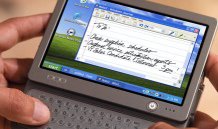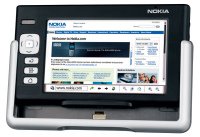Enter the pad computer
I am about to describe something which, ten years from now, could be the most important computing platform. It is a radical vision of the ultimate, optimal, all-in-one mobile device, but it is neither a new nor an original vision. Largely it is just taking our internet- and PC-centric experience of computer use and realizing it in a mobile format.However, what makes this vision interesting is that it has become possible with current technology - and even current products already on the market. I will describe the key characteristics of this device, let us call it a pad computer or simply a pad:
Convergence The pad is not for a single purpose, but provides multiple functionalities. Telephony, video, audio, communication, data. It will run applications which represent and combine these fields - pretty much everything a user might want to do with a computer.
Capability The device will perform many of these functions extremely well. It will have processing power and storage capacity. The user interface will be enjoyable, efficient and convenient. No little buttons to punch multiple times in order to write a single character. No tiny screen to view just a fraction of what you want to see.
Customizability The device will not run a stripped-down, constrained, limited, difficult "mobile OS" but a full-blown modern operating system. Application development will be easy and powerful. Instead of putting the developer into a proprietary sandbox, the software stack provides well-documented layers, each with an exposed, open API for additional or alternative development of the system.
Connectivity Today, no computer is really useful if it doesn't connect to other devices. The most important connection on the pad is its connection to the Internet via a radio link, eg. Wi-Fi. In addition, it can use a secondary radio connection, cables, ports, and slots to transfer data and to use various mobile or stationary devices and little gadgets.
Portability The pad is small, but no too small. You can always carry it with you - it fits conveniently into your handbag or into the pocket of your coat.
This vision is based on my experience that cell phones - even today's smart phones - are very limited. They are nice as phones and (alarm) clocks, but almost useless for other tasks. Communicators are a bit better, but still rather lackluster devices for most mobile use cases. So, why not make a versatile mobile computer instead, and have the telephony functions as just one of the applications? It seems the creators of some mobile devices have thought along the same
lines, for example we have:
 Sony Vaio U-series is a handtop PC which supports regular peripherals like external displays. It comes with the Windows XP Home Edition preinstalled.
Sony Vaio U-series is a handtop PC which supports regular peripherals like external displays. It comes with the Windows XP Home Edition preinstalled.
OQO is another handtop PC which supports external displays etc. It comes with the Windows XP Tablet PC Edition 2005, but like the Vaio, could probably be retrofitted with Linux.

Nokia 770 is a low end pad (at just $350) best suited for web browsing and internet communication. It comes with Linux preinstalled and is based on the Maemo platform, which has been developed by Nokia but is entirely free software. This device has been met with considerable enthusiasm from the open source community as well as pad users.
I could have listed many other devices with some similarity: portable media players, game consoles, etc. None of these and none of the above devices fulfill the complete vision. Instead, they cater to different users and different markets. For example, some users may only really need a camera or some form of entertainment in the mobile context. Or they may actually prefer a separate phone device. Price will also structure the markets, for example into the following:
High end, 1200+ eur Full-blown handtop PCs, like the OQO and the Vaio U-series. These will do almost everything your desktop PC might do, and a bit in addition. They might have built-in data projectors and could interface with a full set of standard PC peripherals. All in a convenient, portable form factor.
Mid end, 400-1200 eur The true carrypads and interweb players. More limited in capacity, but still suitable for a plethora of mobile applications. They would have enough power for good multitasking, smooth full-resolution video and graphic-intensive, fast paced games. They might have gigabytes of internal storage for your mp3 collection.
Low end, 200-400 eur The simple thin clients, internet tablets and surfboards like the Nokia 770. They would be capable of running PC-style software, though web-based applications would work best on them. Web browsing and other forms of less performance-intensive forms of communication would be their domain.
Some of the above slots can be more or less filled with current products, but there is still room for many more. All current markets are niches, as our culture needs to embrace mobility more fully before users will see the need for these kind of complex devices. I would think the markets would most easily start at the low end, since price can be prohibitive for the hesitant early adopters. However, current users of the Nokia 770, for example, are asking for features that would be better embodied in the mid end products. In any case I would expect the pad computer markets to start substantially growing in the next 1-2 years, and we are going to see products at all levels of the market from multiple vendors.
Linux would be the operating system of choice for these kind of devices, due to its many advantages. Because of its scalability, flexibility and openness it fits perfectly into our vision. If mobile or desktop Windows can improve in these areas and provide decent levels of security, it can be a strong player on pad markets as well, in view of its adoption in today's communicators and desktops. Symbian might also develop to meet the pad computing challenges, but in its current state I deem it to be too limited and too difficult for the developer to be a good choice for pads, and one must consider that it does not have a desktop equivalent. MacOSX could be a viable choice, if Apple decides to develop it for mobile devices. However, even though Apple would be stupid to ignore pad markets, it could be better served by the existing mobile versions of Linux, and allowing it to concentrate on device/UI design and branding. iPad, anyone?
In the form factor, there is a bit of room to play, but not much. The Nokia 770 measures 141 x 79 x 19 mm with its 5", 800x480 screen, and the OQO is almost identical in these respects. It should be possible to shrink these devices a little bit without touching the screen. A bit larger device could easily have 6" screen with 1000x600 resolution. (Like the upcoming Vulcan Flipstart.) The Vaio U-series measure about 170 x 110 x 25 mm, which I think is the absolute maximum for this kind of a device. Why? Because this is the size that fits more or less conveniently into the pockets of any of my jackets. A device of this size could be operated with just one hand, or carried comfortably in hand. Any larger, and you will need a separate carrying bag for the device. At that point you could just as well go for an ordinary laptop, which would provide a more powerful user experience. It would no longer be your trusted, handy, carry-everywhere device.
For some applications, such as internet communications or document writing, you will need a keyboard so having an integrated mini-QWERTY keyboard can be a good choice. However, web browsing, video and picture viewing, etc. are more convenient with just a stylus and a few buttons. And you could always use an on-screen keyboard or handwriting recognition. In my mind the best approach would be to just enable external keyboards - eg. foldable bluetooth keyboards comparable to laptop keyboards. This way the user could always choose to use a proper keyboard or just to carry the bare essentials. But like so many things here, users will be different so the available pad models should be different as well.
The term "carrypad", referring to a mid-end pad with a keyboard, was coined by Chippy in his excellent blog, titled Time for the Carrypad ? Chippy's blog fleshes out the capabilities of a carrypad in detail.

0 Comments:
Post a Comment
<< Home